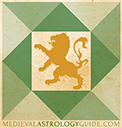Medieval Astrology for the Modern Astrologer
Welcome to the new and exciting world of medieval astrology!
Whether you're new to this type of astrology or new to astrology in general, this series will help you get acquainted with some of the fascinating and useful techniques and tricks of the medieval astrologer.
Of course, you may be wondering why anyone would want to practice medieval astrology since we are no longer in medieval times. For more information on that, be sure to check out our Frequently Asked Questions!
What is it that makes medieval astrology any different from the contemporary modern astrology that is popular all over the internet today? Well, there are actually several differences, both technical and philosophical, that distinguish modern astrology from the astrology that was practiced before the turn of the 18th century. This series will explore these key differences. Let's take a quick look at some of the more apparent ones.
Only 7 Planets
The most obvious difference is that medieval astrology only utilizes the seven classical planets. Uranus, Neptune, and Pluto are typically not included in charts of contemporary practitioners of medieval astrology and if they are, they aren't utilized very heavily. Instead, the classical seven planets are used extensively for their vast symbolism. Also, more advanced techniques exclude the outer planets which naturally results in them being utilized less often, if at all.
Planets are More Important than Signs
While modern astrology emphasizes the characteristics of the twelve signs of the zodiac, medieval astrology stresses the importance of the planets. Planets act and initiate changes, so it's more rewarding to keep an eye on them and how they impact or shape the parts of the chart they are connected to. Where Pisces falls in a chart, for example, is much less important than where any planet is placed and a sign's position in a house mostly serves to point the astrologer to the planet that rules the house in question.
The Chart is Outside of You
Medieval astrology is much more focused on ascertaining if areas of an individual's life are objectively conventionally good and how they are operating. This allows an astrologer to see weaknesses in areas of life that are inherently more difficult for someone to obtain or enjoy and develop strategies to fix it. In this system, the eleventh house isn't what you think or feel about friendship; it is your friends. How they act, what they are like, and if they are good for you.
Your Whole Chart Isn't Working at Once
A really critical difference is that medieval astrology doesn't see the whole natal chart as entirely operational at any given moment in time. Different planets or points in a chart activate or deactivate in techniques called "time lord systems" or "chronocators". At any given time, one or two planets are activated and emphasized, showing that the areas of life they impact or are responsible for are especially important while other planets and their corresponding life areas fade into the background.
You are Not Your Sun Sign
Modern astrology has done a really thorough job of training people to relate to their Sun sign, but this is actually a very recent method of approaching a chart. For most people, the sign the Sun is in is actually of little consequence, at least when it comes to their personality or character. What's more likely to be important are planets in significant places; like in the first house. These color the personality and physical appearance. The most significant planet in terms of character is the Lord of the First, the planet who rules the sign on the Ascendant.
